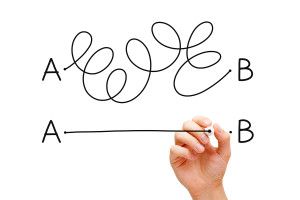Strategic Selling Process – Need One?

For many companies, structuring a strategic selling process for conducting sales is an afterthought…when, really, it should be at the forefront of all that you do! A proper selling process enables your company to define, prepare for, quantify, track, and increase sales success.
Otherwise, when left to their own devices, salespeople tend to “wing it,” be mavericks, or sell in their own “unique” ways, which is not only unreliable, it makes it nearly impossible to predict sales, identify areas for improvement, or to make sales behaviors better align with customers’ buying behaviors.
So, what is a process-less company left to do? Below are a few tips on developing your own strategic selling process.
Developing a Strategic Selling Process
1. Start by clarifying your sales philosophy. Different than your company’s mission statement, a sales philosophy is how you see sales or selling in relation to your buyers or customers. A short example would be, “Selling is about identifying the buyer’s needs and customizing a solution to fit those needs with our products/services.” Your sales philosophy will be your constant guide in developing, implementing, and revising your sales process.
2. Identify customer profiles. Who is your ideal customer? Who is the typical customer in your existing customer base? What kinds of customers in your existing customer base tend to have the most problems or complaints? What kind of customer needs your products/services? Your CRM system, if you have one in place, is a good source for this information.
3. Describe your most effective sales behaviors. Based upon your customer profile, you need to determine:
- What your customers need to know, understand, and feel to interact with your salespeople and ultimately purchase
- What your salespeople need to know, understand, and feel to interact with your potential customers and ask for the business
Do your sales require lots of technical explanation or is interaction minimal? What can stall sales? What keeps the sales process moving forward? What turns customers on and off? If you’re finding that many potential buyers are putting on the brakes when they feel they don’t understand, then perhaps you should structure a sales process that incorporates user-friendly tutorials. If on the other hand, you find buyers back away from sales when they have too much time or information, then try structuring a sales process that remains simple and swift.
4. Develop a model of your sales process. Include a visual aid to map out the behaviors of your sales interactions – a Client Interaction Model. This model should identify milestones to help your salespeople know where they are in the sales process. It should also show how and where the different parts of your sales process fit together. When should your salespeople be asking questions? Where do your salespeople need preparation time? Where do price discussions fit in?
5. Implement the strategic selling process.
Proper implementation is key to the success of your selling process. Here’s a general checklist:
- Communicate your goals to your salespeople and their support team
- Define the concepts
- Explain the steps and timeline of your sales process (using your model)
- Describe the actions required
- Create documentation (either hard copy or software system) to track steps and actions
- Take measurements and evaluate meaningful data
- Provide opportunities to evaluate and give feedback on performance
- Solicit feedback from your salespeople
Empower your sales team to succeed in implementing your structured sales process by making the process as clear to perform as possible, by expecting your sales team to follow the process as outlined, and by improving the process with their feedback and hands-on experience.

- Account Planning (16)
- Awards (42)
- Client Testimonial (37)
- Personal Branding (21)
- Podcast (12)
- Research (77)
- Sales Career Development (90)
- Sales Coaching (164)
- Sales Consulting (141)
- Sales Culture (181)
- Sales Enablement (380)
- Sales Leadership (110)
- Sales Management (267)
- Sales Negotiation (11)
- Sales Prospecting (136)
- Sales Role-Playing (19)
- Sales Training (242)
- Selling Strategies (279)
- Soft Skills (78)
- Talent Management (101)
- Trusted Advisor (29)
- Virtual Selling (57)
- Webinar (13)

























